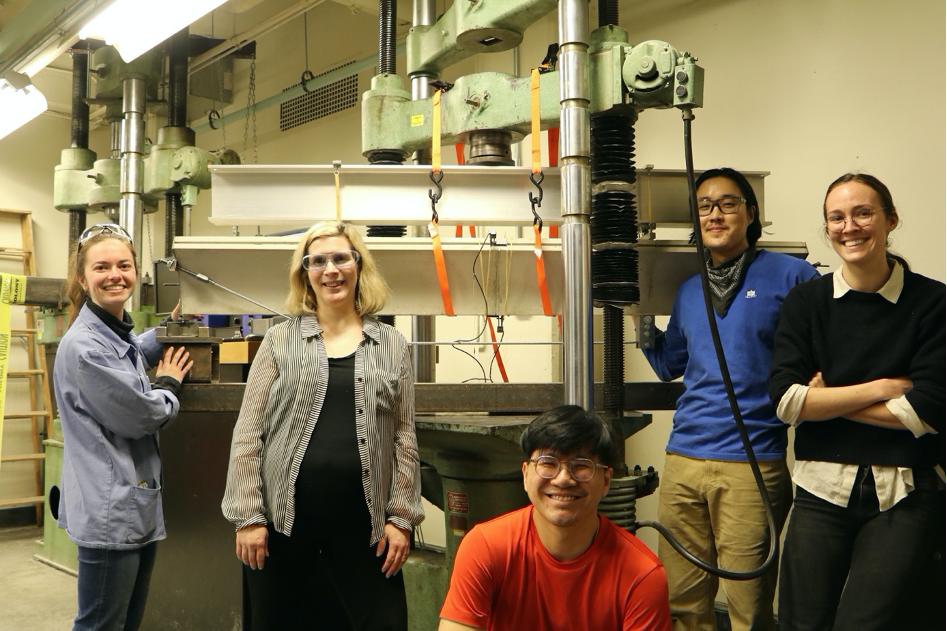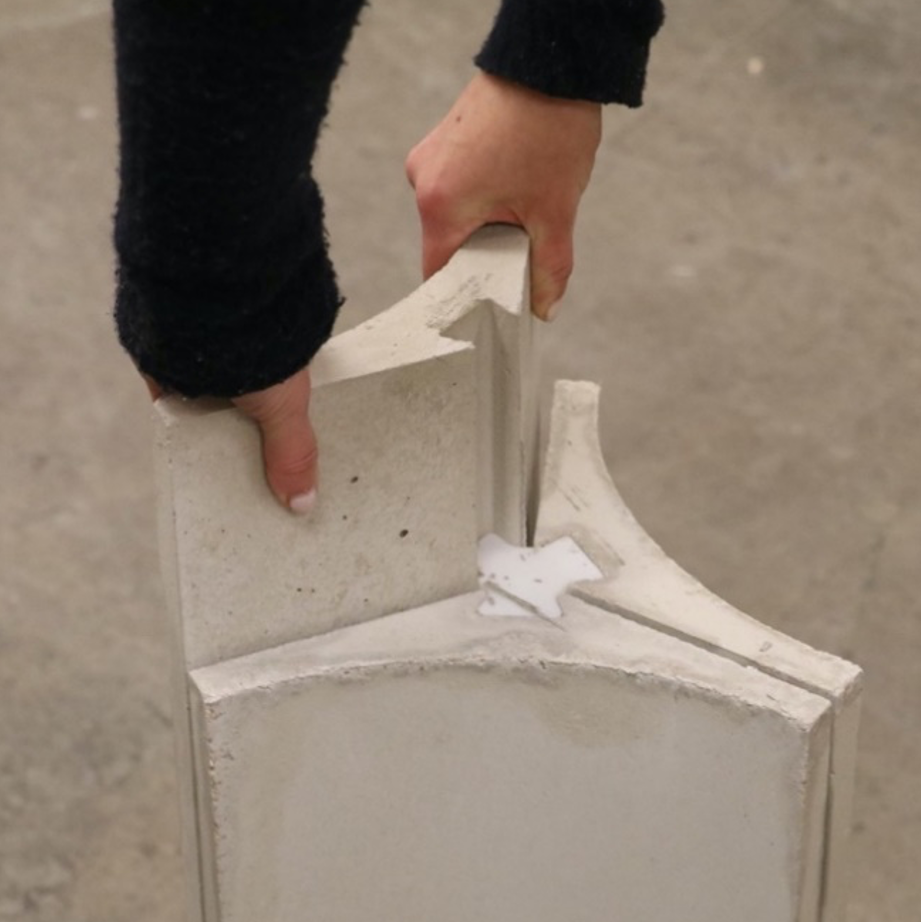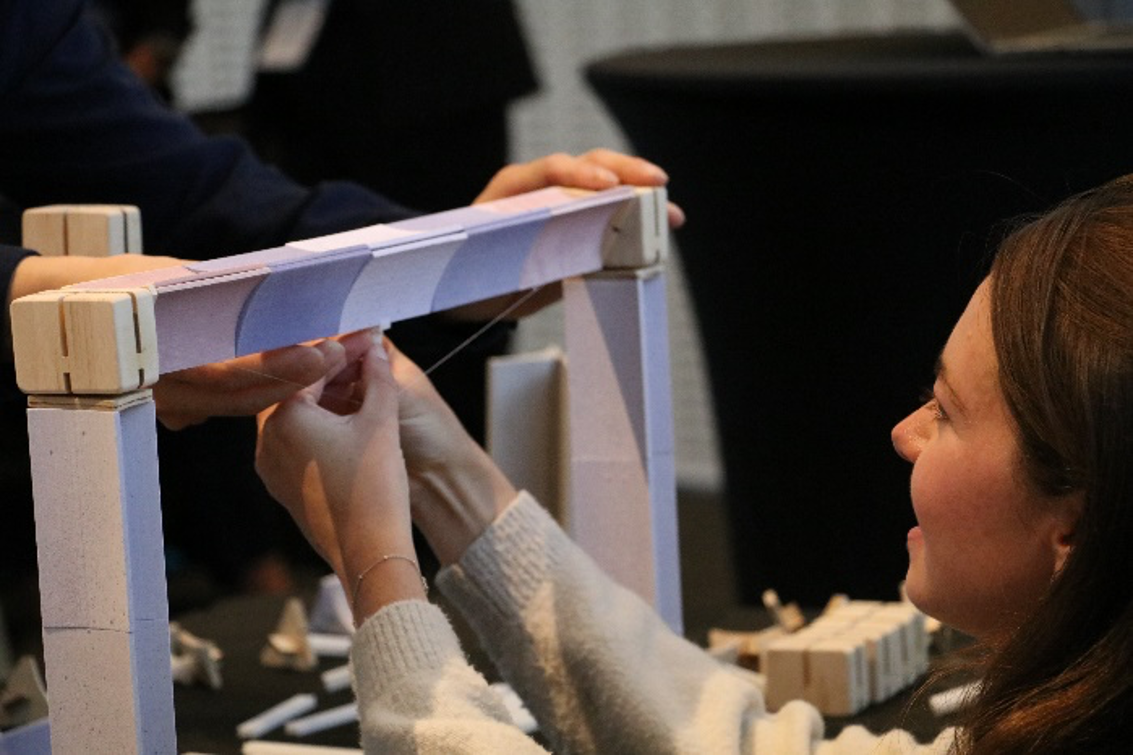Design & Computational Strategies for Reusable Concrete Components
June 14, 2023

Professor Caitlin Mueller (second from left) and her team, working on concrete reuse. Photo courtesy of the Mueller Group.
Concrete is a ubiquitous construction material due to its accessibility, strength, durability, and affordability – but its production, which involves cement, is carbon-intensive, requiring high temperatures and emissions in its production. Innovations in concrete reuse, especially given the concrete industry’s vast scale, could accelerate a more sustainable architecture, engineering, and construction (AEC) sector. A team of researchers at MIT, led by Caitlin Mueller, Associate Professor of Civil and Environmental Engineering and Architecture, are exploring a promising strategy for concrete reuse, through the support of the MIT Climate & Sustainability Consortium (MCSC) – developing design and computation strategies that would allow the concrete building elements to be disassembled and rebuilt several times, reducing the environmental impact of the structural system. The work, a system called PixelFrame, closely aligns with the MCSC’s focus area on circularity, a strategy that aims to reduce the material footprint of products through material recovery and efficient material use.
The team, which includes Inge Donovan and Jenna Schnitzler (MArch + SMBT), Emily Liu (B.Eng), Pitipat Wongsittikan (SMBT), and PhD student Keith Lee, is designing reusable concrete building components, and recently built and tested their first prototype at half-scale, an important milestone. They are collaborating with industry experts at Holcim, a leader in innovative and sustainable building solutions, and Prologis, a leader in logistics real estate with a focus on high-barrier, high-growth markets. In particular, Ryan Roberts, Group Head of Sustainable Construction at Holcim, and Forrest Etter, Director of Design and Construction Innovation at Prologis, have shared critical insights and expertise as the project continues to progress.
“Structural element reuse is an important method for reducing embodied carbon in the building industry,” says Mueller, who works at the boundaries of architecture and structural engineering. “In order for this approach to become widespread and effectively adopted, industry expertise is necessary, so it is valuable to have the opportunity to loop in our collaborators at Holcim, and other MCSC companies, on this work. The industry perspective will help ensure our research is implementable, and allow us to have a positive impact on industrial decarbonization and material innovation sooner.”
“It has been incredibly valuable to collaborate with experts at MIT on developing creative approaches to circularity and reuse in the building materials and solutions industry,” said Magali Anderson, Chief Sustainability and Innovation Officer at Holcim and member of the MCSC’s Industry Advisory Board. “There are many considerations from the industry side that can be interwoven into this important conversation about sustainable building solutions – centered on near-time feasibility for specific projects, as well as longer-term, industry-wide shifts.”
This feedback ties into the key themes that also resonated across many MCSC member companies at a discussion about circularity challenges last fall. Participants emphasized the importance of understanding industry’s response to policies, as well as exploring opportunities to educate governing bodies, providing a voice to business coalitions, and setting examples for how policy could be designed to enable correct alignment of incentives.

"Structural element reuse is an important method for reducing embodied carbon in the building industry. In order for this approach to become widespread and effectively adopted, industry expertise is necessary, so it is valuable to have the opportunity to loop in our collaborators at Holcim, and other MCSC companies, on this work."
PixelFrame system
“Pixels” are the base element, or the minimum building block, of PixelFrame. The pixels consist of fiber-reinforced modules with a constant geometry and varying concrete mix to create a “pixel palette” of diverse structural capacities. To maximize reuse potential, there is no internal steel reinforcement, as corrosion of the embedded steel due to water infiltration is one barrier to reuse for concrete. Unlike traditional concrete beams and columns, which are long rectangular elements reinforced with internalized steel rebar, PixelFrame breaks down each structural element into segments, leveraging modularity to make building elements completely demountable and reusable at end-of-life.
Since the use of grout or mortar would impede reusability, all the connections are dry-jointed, and the elements are held together using steel post-tensioning. The conventionally fused assembly of steel and concrete is separated, allowing each material to respond independently to tensile and compressive forces without impeding the longevity or function of the other. By using resources such as steel and concrete more efficiently, the PixelFrame system is allows for more than 50% up front embodied carbon savings, and even more after future reuse.
Pixels, the base element of the design. Photo courtesy of the Mueller group.
Data and computational strategies guide design
The PixelFrame components are designed using computation, which helps determine the frequency and distribution of load demands. This data-driven approach is a key advancement beyond typical one-off engineering approaches used in building design today. Once the model is complete, testing it is the next step. The team then uses data to check whether the models are correct, and if not, recalibrations can help adjust the design accordingly.
“Our goal with PixelFrame is to design, build, and assemble a manageable, finite kit of parts that can withstand a wide range of use cases without significant overdesign,” says Lee. “Efficient discrete design requires anticipation and understanding of demand variation.”
This means that part of the team’s research is anticipating the needs of the future – the strength the blocks will need to have. For a structural system to work across many spans, load demands, and lifetimes, durability is key.
“To design a structural system, we need to understand the full range of loads that must be resisted,” says Schnitzler.
Computational tools can also help streamline construction supply chain logistics and procurement. “Computation helps us design smarter buildings in a future where design should be influenced by reused element inventories, maximizing reuse,” says Lee.

Assembling the demountable PixelFrame cross section. Photo courtesy of the Mueller group.
Implementable strategies: a positive impact sooner
Considering reused element inventories, through a design lens, is an important part of the circular economy.
“The building industry today perpetuates wasteful construction paradigms of difficult-to-reuse materials, as structures are designed with little consideration for building material availability,” adds Donovan. “Our design and material specification processes are closely linked to material inventories, and components and structures are designed with disassembly and reuse in mind.”
The reversible building system that Mueller and her team have developed works with current building codes and available concrete mixes. The team’s four-step design tool allows them to create a 3D massing that is compatible with a given inventory by performing a structural analysis that matches demand to inventory and assigns structural elements to a computational model.
“There is an emerging field of design with constrained inventories that is fundamentally different than building with new supply chains, which PixelFrame embraces,” says Professor Mueller. The system is also designed within architecture code standards, with reversibility, reduction, versatility, and feasibility as the guiding principles.
This question of how implementable, or feasible, their design is, ties into other related conversations and research at MIT.
One example is a project by Siqi Zheng, the STL Champion Professor of Urban and Real Estate Sustainability and Randolph Kirchain, principal research scientist and co-director of MIT Concrete Sustainability Hub. Through an MCSC Seed Award, they are investigating barriers, such as uncertainty about the supply of and demand for recycled materials, and opportunities for increased circularity of building materials and how to overcome those barriers for construction materials.
This type of research may inform and support the implementation of new tools being developed to support the circular economy, such as PixelFrame.

Testing the concept at 1:10 scale at the MCSC annual symposium. Photo courtesy of the Mueller group.
Recent milestone: half-scale test
The team recently hit an important milestone of fabricating their half-scale test of a two meter beam.
After three days of casting concrete, they left the pixels to cure and started on the steel fabrication to build the steel post-tensioning system. Once the pixels had finished curing, the assembly began, with the beam coming together quickly. The beam underwent a load test with minimal deflection, linear elastic behavior, and little to no damage to the parts, which were assembled fully reversibly, without mortar, adhesives, or welding.
“We assembled and disassembled the beam twice, which was a great way to prove our hypotheses for how to maximize reuse potential,” concludes Donovan. “We look forward to testing out new reconfigurations and sizes as PixelFrame continues to develop, evolve, and improve.”
As a next step, the team is excited to begin testing the system at full scale, an important step to validate the computational models and to ensure that the system is building code compliant. The team is consulting with Holcim to finalize an extensive list of tests, including fire resistance testing, durability testing, and load testing.
